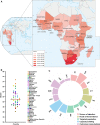Assessment of performance for a key indicator of One Health: evidence based on One Health index for zoonoses in Sub-Saharan Africa
- PMID: 36273213
- PMCID: PMC9588233
- DOI: 10.1186/s40249-022-01020-9
Assessment of performance for a key indicator of One Health: evidence based on One Health index for zoonoses in Sub-Saharan Africa
Abstract
Background: Zoonoses are public health threats that cause severe damage worldwide. Zoonoses constitute a key indicator of One Health (OH) and the OH approach is being applied for zoonosis control programmes of zoonotic diseases. In a very recent study, we developed an evaluation system for OH performance through the global OH index (GOHI). This study applied the GOHI to evaluate OH performance for zoonoses in sub-Saharan Africa.
Methods: The framework for the OH index on zoonoses (OHIZ) was constructed including five indicators, 15 subindicators and 28 datasets. Publicly available data were referenced to generate the OHIZ database which included both qualitative and quantitative indicators for all sub-Sahara African countries (n = 48). The GOHI algorithm was used to estimate scores for OHIZ. Indicator weights were calculated by adopting the fuzzy analytical hierarchy process.
Results: Overall, five indicators associated with weights were generated as follows: source of infection (23.70%), route of transmission (25.31%), targeted population (19.09%), capacity building (16.77%), and outcomes/case studies (15.13%). Following the indicators, a total of 37 sub-Sahara African countries aligned with OHIZ validation, while 11 territories were excluded for unfit or missing data. The OHIZ average score of sub-Saharan Africa was estimated at 53.67/100. The highest score was 71.99 from South Africa, while the lowest score was 40.51 from Benin. It is also worth mentioning that Sub-Sahara African countries had high performance in many subindicators associated with zoonoses, e.g., surveillance and response, vector and reservoir interventions, and natural protected areas, which suggests that this region had a certain capacity in control and prevention or responses to zoonotic events.
Conclusions: This study reveals that it is possible to perform OH evaluation for zoonoses in sub-Saharan Africa by OHIZ. Findings from this study provide preliminary research information in advancing knowledge of the evidenced risks to strengthen strategies for effective control of zoonoses and to support the prevention of zoonotic events.
Keywords: One Health index; One Health performance; Sub-Saharan Africa; Zoonoses.
© 2022. The Author(s).
Conflict of interest statement
The authors have no other competing interests to disclose.
Figures




References
-
- WHO: FAO, OIE, and WHO launch a guide for countries on taking a One Health approach to addressing zoonotic diseases. 2019. https://www.who.int/news/item/11-03-2019-fao-oie-and-who-launch-a-guide-.... Accessed 08 Apr 2022.
-
- FAO, OIE, and WHO launch new online training on navigating the Tripartite Zoonoses Guide (TZG). 2020. https://www.who.int/news/item/24-09-2020-fao-oie-and-who-launch-new-onli...). Accessed 15 Apr 2022.
-
- WHO: New international expert panel to address the emergence and spread of zoonotic diseases. 2021. https://www.who.int/news/item/20-05-2021-new-international-expert-panel-.... Accessed 08 Apr 2022.
MeSH terms
Grants and funding
LinkOut - more resources
Full Text Sources

